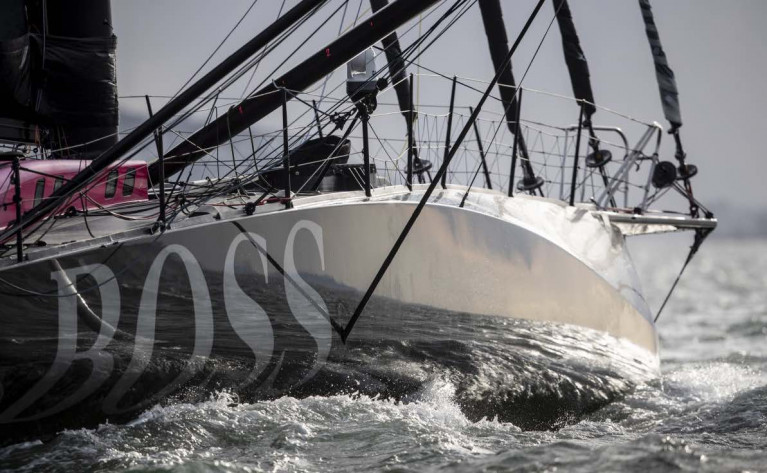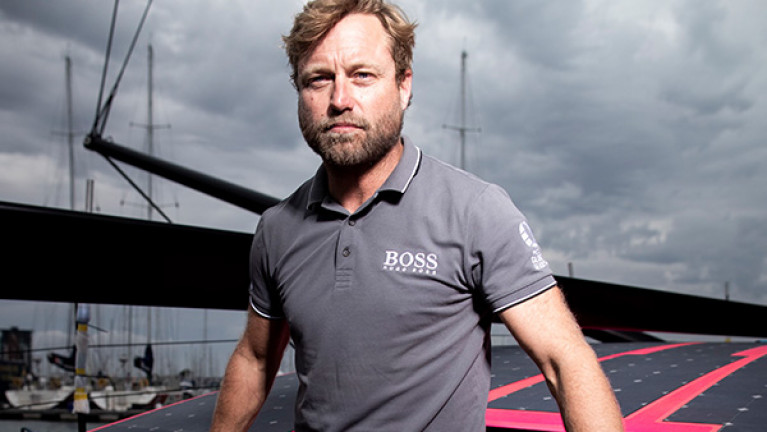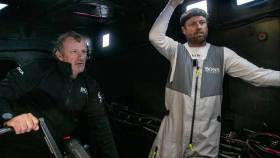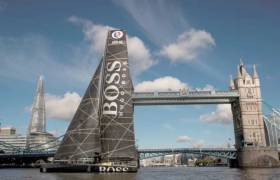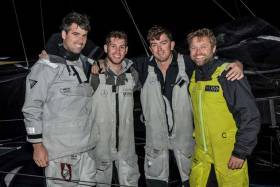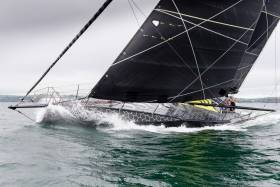Displaying items by tag: Alex Thomson
Alex Thomson Leads Vendee Globe by 26 Miles Thanks to Storm Theta
Alex Thomson leads the Vendée Globe by some 26 nautical miles this afternoon, first to deal with the worst of storm Theta at some 250 miles south of the Azores. The British skipper took Hugo Boss close to the centre of the system as he considered prudent, before a difficult gybe in around 40ks of wind and 5-metre seas around 1330hrs this afternoon, a move which should see him gain significantly on all but the French veteran Jean Le Cam who took a similar track.
The reward for the extra risk is sailing fewer miles than the rivals who are chasing him is being slingshotted out of the low in strong N NW’ly winds which, all going well, should net him significant miles on his fast foiling rivals.
Thomson’s nearest pursuer is 61-year-old Jean Le Cam whose ocean racing history dates back to the 1980s and who won La Solitaire du Figaro three times and finished second in the Vendée Globe in 2004-5. He is sailing a 2007 launched boat with conventional straight daggerboards and leads all of the latest generation foilers other than the radical black HUGO BOSS.
Le Cam is more than twenty miles up on the third-placed Nico Troussel on CORUM L’Épargne.
“I see them behind me these foilers. But as long they are there papy fait de la resistance (literally grandpa resists ed note 1983 french film)! I am 70 miles from the centre of the Theta depression. I am under mainsail alone, I am waiting to see what I am going to do. I always say, do not confuse speed and haste. Here I am calm, the wind rises gradually, it is useless for me to have up sail I won’t need in half an hour. That's the worst thing, you put it up you put it down put it up.
Asked on the Vendée Globe LIVE show today about his passionate public following in typical Le Cam style he quipped, “I'm glad people are with me because this is not an easy adventure. And here I am. I can't not be happy! If I'm not happy there, then I'll never be happy! So I'm happy. I ate a cassoulet this morning, I found the cassoulet to go well with a depression. It does not go with the high pressure but rather with the depression. This is our culture in Brittany. Otherwise, I have sweetbreads to make, but I'll wait a bit. "
“This is the first hors d'oeuvre of this Vendée", was Kito de Pavant’s description of storm Theta during the Vendée Live programme. De Pavant is a three times a Vendée Globe starter who has not yet finished and who had to be rescued in the Southern Ocean by the Marion Dufresne supply ship during the last edition. Seeing the pace and passion of his friend and many times adversary Le Cam. De Pavant teased, “Maybe there is still a place for old people!”
Strategies for Theta vary all the way through the fleet. First timer Clarisse Cremer on Banque Populaire X admitted to being freaked out by it. Louis Burton today said he would play it safe, setting his cursor where he feels comfortable between speed and safety. And then are those who keep smiling, like Kevin Escoffier, busy maneuvering further west in 30 knots of wind at midday.
The PRB skipper Escoffier highlighted the need to keep the hammer down as much as possible to avoid being left behind in a situation which is not so much rich get richer as the poor being left behind in a vacuum of anti cyclonic very light winds.
Escoffier said. “Water started coming into the boat just before I gybed at the depression. Here we go again! It took a fair bit of time to empty everything; the pumps are fast but it still took me 2 hours. When you discover that, after taking a little nap...Well, let’s just say there's nothing like it, it definitely wakes you up! (he says laughing) I'm currently sailing in 30/35 knots, sailing downwind. I’ve given in to losing a bit of speed so that I can shift a little to the west and remain in control. I've moved away from the optimal route, but I'm going to sail as well as I can. Alex and Jean are making a very good start to the race. I made the decision to hang back a little and I'm not alone. Charlie gybed again this morning for the same reasons. I completely understand what Alex and Jean are doing, but everyone has their own path to take. These are never easy choices! I'm going to come out of the depression early tonight. I am happy with my start to the race. This is my second solo regatta and I'm trying to do it right. I've stayed in contact with good boats with good skippers at the helm. I'm proud of that no matter what happens afterwards.”
Meanwhile, some 300 miles to the northeast, back up the track Miranda Merron and Didac Costa were among those stuck in the light winds and oily seas.
And true to the Vendée Globe’s requirement to fix at least one thing a day, Sébastien Simon (ARKEA PAPREC) took advantage of being close to the Azores to climb to the top of the mast without succeeding in completely solving the problem (damaged wind vanes). Maxime Sorel has been dealing with autopilot problems. And Louis Burton transformed the Bureau Vallée 2 saloon into a “composite workshop” to repair a crack in a bulkhead. "I'm apprehensive the next time we go upwind in heavy seas," he explained.
Vendee Globe Favourite Alex Thomson Interview
The Royal Ocean Racing Club in London has released a special edition of its Time Over Distance video series with Louay Habib talking to Alex Thomson just days before Alex and HUGO BOSS started the 2020 Vendee Globe.
This is Alex Thomson's fifth race and having come second last time, Hugo Boss is one of the favourites.
The interview was recorded live with Alex exploring the physical and mental strength required for the race, plus details of the radical IMOCA 60 design and the cutting-edge technology on board.
Alex Thomson has returned to the water onboard HUGO BOSS, the boat which he hopes will lead him to victory in the 2020 Vendee Globe.
Thomson who has strong links to Cork Harbour and is a former Afloat Sailor of the Month now has less than five months to go until the start of the round-the-world endeavour, dubbed the Everest of the Seas.
Thomson and his team - much like their competitors in the IMOCA class - were unable to train on the water for some 9 weeks due to the COVID-19 pandemic. Following the easing of lockdown restrictions in England, however, the team have been able to return to the water to commission the yacht, before re-commencing their training.
The news comes as organisers of the Vendee Globe this week confirmed that the race - which takes place just every four years and is considered the pinnacle event in the offshore sailing calendar - will indeed go ahead as planned on 8th November from Les Sables-d’Olonne in western France.
With less than five months to go until the start of the round-the-world endeavour, Thomson has made clear the team’s sole focus over this period will be maximising their time on the water and optimising the performance of the HUGO BOSS boat.
Over the coming weeks and months, Thomson and his crew will train offshore in a bid to further develop and enhance the performance of the HUGO BOSS boat, which launched in the summer of last year after more than two years in design and build. Thomson will also complete his solo 2,000 nautical mile passage, a final qualification requirement for the Vendee Globe.
“We feel in really good shape” he continued. “Of course, like all the teams, we’ve lost time on the water but that was out of our hands. The team has adapted well and we’ve really made the most of this period. Now it’s about putting the knowledge we’ve gained - and projects we’ve worked hard to develop - to the test. We’re now a few days into our training and I’m very pleased with the decisions that we’ve made so far. HUGO BOSS is performing very well indeed!”
Thomson & McDonald Look for Port of Refuge After Damage to Hugo Boss
Transat Jacques Vabre competitors Alex Thomson and Neal McDonald are working on the safest place to navigate their damaged 60ft monohull, Hugo Boss, after announcing their withdrawal from the 14th edition of the offshore race.
As Afloat reported earlier, the British duo informed the TJV race office that they were withdrawing from the race with the keel of their brand new 60ft monohull attached only by the hydraulic ram after hitting something in the water whilst travelling at around 25 knots at 09:57 UTC.
Hugo Boss had completed just over a third of the 4,350-mile course of this biennial double-handed race to Salvador de Bahia, Brazil - the longest and toughest in the sailing calendar. It will be little comfort to Thomson that his situation would appear to be a lot better than when he was helicoptered to safety after capsizing his previous boat in 2015.
"Hugo Boss had completed just over a third of the 4,350-mile course"
Both skippers were working with their technical team on the best destination. The newly-launched and much admired Hugo Boss is in the middle of the Atlantic Ocean, about 420 miles southwest from Madeira and 380 miles northwest of the Canary Islands.
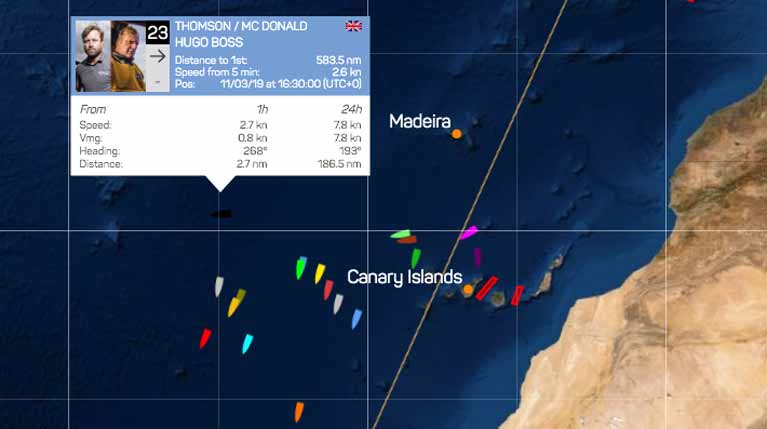 Hugo Boss is about 420 miles southwest from Madeira and 380 miles northwest of the Canary Islands
Hugo Boss is about 420 miles southwest from Madeira and 380 miles northwest of the Canary Islands
Hugo Boss Out of Transat Jaques Vabre With Keel Damage
British skippers Alex Thomson and Neal McDonald (Hugo Boss) are out of the Transat Jacques Vabre Race after hitting an object at sea this morning just a week into the offshore race.
The much-fancied British entry that has strong ties to Cork Harbour was 18th of the Imoca race to 484.84 nautical miles leaders Jérémie Beyou and Christopher Pratt (Charal).
Following the incident, Alex and Neal stopped the boat and carried out an inspection to assess the damage sustained. It became apparent that the keel is now only attached by the hydraulic ram.
The new yacht was launched in August as Afloat reported here.
Due to the damage sustained to the boat, the decision has been made that Alex and Neal will not continue on in the race.
The Alex Thomson Racing team is now working to assist the skippers to bring the boat to the nearest port.
Both Alex and Neal are currently safe inside the boat and did not sustain any major injuries.
Thomson Sets New Monohull Speed Record On Hugo Boss
British offshore skipper Alex Thomson and his crew sailing the IMOCA 60 Hugo Boss have officially broken the 24-hour distance record for a 60ft monohull, as Sail-World reports.
Thomson — who sailed with fellow 2020 Vendée Globe challenger Nin O’Leary on Hugo Boss last year — raced 539.71 nautical miles over the course of 24 hours, breaking his own extant record set last year by 2.9nm.
The new record was ratified last week after the feat achieved on 19-20 July during a transatlantic crossing from New York to the UK. Sail-World has more on the story HERE.
Hugo Boss Backs Sailor Alex Thomson for Vendée Globe 2020
British sailing team, Alex Thomson Racing, that visited Irish shores this Summer today announced that their long-term sponsor, HUGO BOSS, has extended its partnership with the team for a further four years, in a deal that will take them through to the end of 2021.
HUGO BOSS has sponsored offshore solo sailor Thomson and his team since 2003 in what is one of the longest and most coveted partnerships in sailing. They will retain their title sponsorship rights meaning that Thomson’s IMOCA 60 racing yacht will continue to take the name of the upper premium fashion brand.
The renewed backing strengthens the Alex Thomson Racing team’s position as an early favourite for the Vendée Globe in 2020. The race, which has been in existence since 1989 and occurs every four years, sees sailors spend over 70 days at sea, has only ever been won by a French skipper. Thomson, who finished third in 2013 and second in 2017, will make sporting history if he wins the solo, non-stop, round the world race.
The Vendée Globe starts and finishes on the west coast of France. It is a 26,000 mile lap of the planet, non-stop, solo, and unassisted. With less than 100 people having ever completed the race, and only 50% of boats that start the race making it to the finish line, it is renowned as one of the world’s toughest, competitive sporting challenges. The race pushes sailors to the limit, both physically and mentally. In the 2016/17 edition, Thomson and Frenchman Armel Le’Cleach were in a constant battle for first place, neck and neck all the way to the finish line. Thomson finished just hours behind eventual winner Le’Cleach after 74 days at sea, breaking a world speed record in the process.
Alex Thomson Racing’s Cork Harbour based CEO Stewart Hosford said “We have a fantastic partnership with HUGO BOSS, and we are delighted to announce the continuation for the next four years. As a team we have set the benchmark for delivering value as one of the world’s leading sailing teams; we work hard to ensure we win on the water and deliver value and return off the water. With our strategy and objectives clear, and the continued relationship with HUGO BOSS confirmed, we are in a good position to focus on 2020 and there remains an opportunity for additional partners to join the team. Our values are closely linked with those of our sponsors and many global brands.”
Looking forward to 2020, and with his sights set firmly on the bringing home the gold, Thomson said; “I am looking forward to another successful cycle, with the focus on building the best team, boat and campaign for the Vendée Globe in 2020. As our main sponsor, HUGO BOSS have supported the team and enabled us to push boundaries and innovate both in our approach to sailing and the ways in which we share our sport with our audience. I very much look forward to building on the successes we have achieved and working together over the next four years.”
Mark Langer, CEO HUGO BOSS AG, added: “Alex Thomson is an outstanding sportsman and for us a great brand ambassador. Together with him and his team we can look back on many incredible moments both on and off the water. We are delighted to continue our successful partnership.”
Royal Cork's Nin O’Leary Shares Hugo Boss’s Success in Middle Sea Race
George David’s Rambler 88 has taken line honours for the owner’s third time in the 608-mile Rolex Middle Sea Race currently finishing in Valetta writes W M Nixon. But Nin O’Leary and Alex Thomson in the IMOCA 60 Hugo Boss have turned in a virtuoso offshore performance to be third home across the line, bested only by the significantly larger Rambler and the 100ft Leopard.
Unlike the Fastnet Race 2017, where Hugo Boss suffered from having to beat the whole way from Cowes to the Fastnet Rock, thereby leaving inadequate space and distance to demonstrate her formidable offwind capacity, in this race the “lovely black boat” was able to lay the course – albeit in often very light winds – most of the way on the anti-clockwise circuit towards the most northerly turning point, the volcanic island of Stromboli.
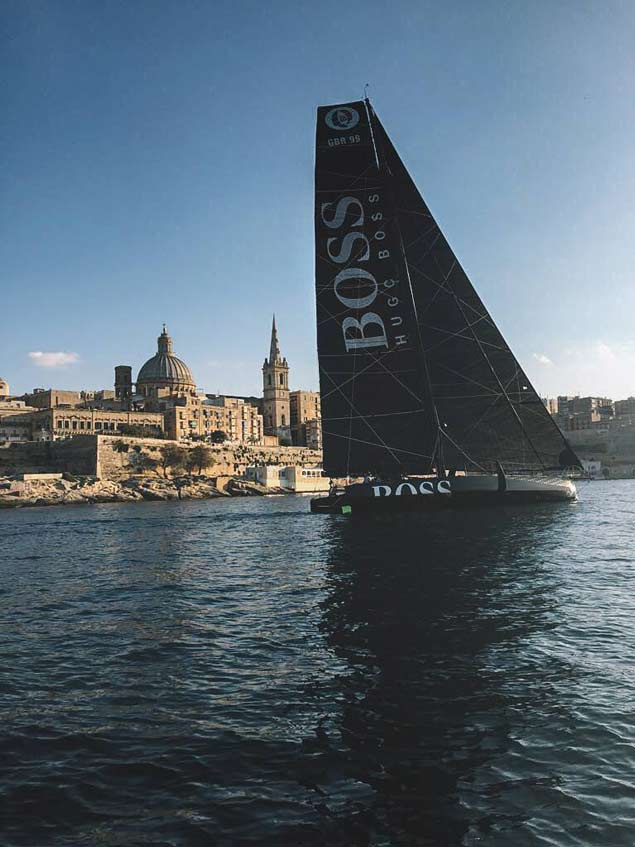 Hugo Boss gets smoothly away from Valetta at the start. Although winds were light all the way to the northerly turn at Stromboli, they were seldom dead on the nose and the specialised IMOC 60 was able to stay well placed. Photo: Kurt Arrigo
Hugo Boss gets smoothly away from Valetta at the start. Although winds were light all the way to the northerly turn at Stromboli, they were seldom dead on the nose and the specialised IMOC 60 was able to stay well placed. Photo: Kurt Arrigo
There, with a west to nor’westerly filling in to eventually become a classic Mistral-generated Mediterranean gale, most of the fleet elected for long tack/short tack progress towards Sicliy’s decidedly rugged northwestly coast’s series of massive headlands. But Hugo Boss’s crew chose to continue to lay on port tack far offshore, accepting the reality that right-on windward work is not their boat’s strong suit.
Thus they found both a slightly more favourable slant of wind well offshore, and a more regular sea state. The northwest corner of Sciliy is notorious for its confused back-wash ridden sea, and when Hugo Boss closed with the fleet again yesterday morning, they were already approaching Sicily’s most westerly race turn at Favignana island, finding themselves in company with the larger boats, and now well ahead of 50ft to 65ft craft which had been hassling them earlier in the race.
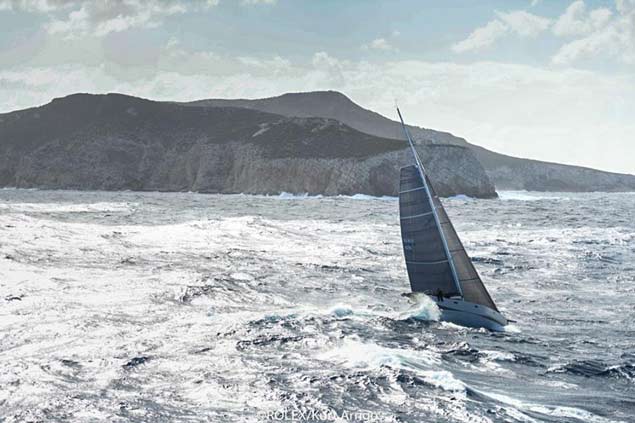 The Botin 65 Caro (Maximilian Klink, Germany) kicks her heels in heavy winds in the backwash-plagued rough seas off Sicily’s northwest coast. Boats that gave much of this coast a good offing, such as XP-ACT and particularly Hugo Boss, benefitted from more regular seas Photo: Kurt Arrigo
The Botin 65 Caro (Maximilian Klink, Germany) kicks her heels in heavy winds in the backwash-plagued rough seas off Sicily’s northwest coast. Boats that gave much of this coast a good offing, such as XP-ACT and particularly Hugo Boss, benefitted from more regular seas Photo: Kurt Arrigo
With Favignana astern, it was all systems go, and at the front of the fleet while Rambler 88 – which was to cover the final 300 miles in 14 hours – was unassailable, for a while Hugo Boss looked as though she might be able to pip Leopard for second place on the water.
It was not to be, as things were easing slightly as the leaders came into Valetta late last night and in the small hours of this morning. With the pace dropping. Rambler 88 was able both to finish first and beat Hugo Boss on corrected time, albeit by just 5 minutes and 26 seconds. But O’Leary and Thompson and their crew of Will Jackson and Jack Trigger (there’s only room for two extra on the very purpose-designed IMOCA 60) were able to beat Leopard (Pascal Oddo, France) by 55 minutes on CT, while Udde Ingvall’s super-skinny Maxi 98 CQS from Australia has finished fourth across the line, almost ten hours astern of Hugo Boss on corrected time.
The severe conditions north of Sicily have taken their toll of the fleet and Irish entries, with Two-Handed favourites Brian Flahive of Wicklow and Sean Arrigo of Malta with the J/122 Otra Vez an early retiral, while Conor Doyle of Kinsale with the DK 46 Hydra had managed to get as far as the great headlands of northwest Sicily before pulling out.
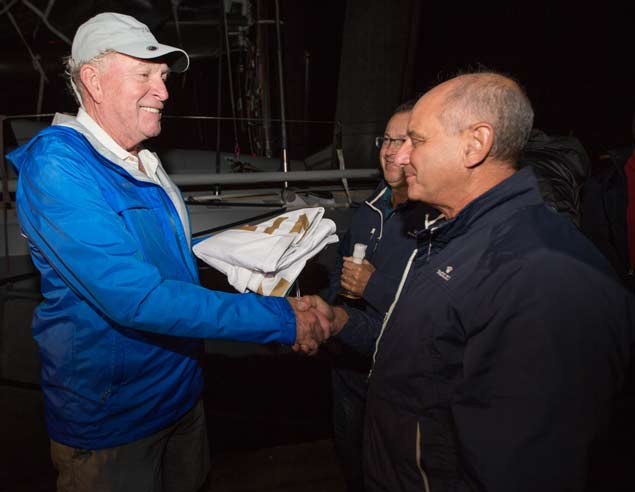 He’s done it again. George David (left) receives the line honours flag for the third time from Royal Malta YC Commodore Godwin Zammit
He’s done it again. George David (left) receives the line honours flag for the third time from Royal Malta YC Commodore Godwin Zammit
But Ireland’s most experienced participant, Middle Sea Race 14-times veteran2012 Barry Hurley, is sailing a really cool race with Shane Giviney and other noted talents on the Xp44 XP-ACT. Having given those bouncy northwestern headlands a decent offing to get them quickly clear while maintaining a good fleet place, they’ve just passed Pantellaria and are lying fourth overall on corrected time.
Current handicap leader is the 2012 Swan 53 Music (James Blackmore, South Africa) while the Russian JPK 10.80 Bogatyr (Igor Rytov) is second and the former Round Ireland star Tonnere de Breskens, the Ker 46 now known as Tonnere de Glen and owned by Tian Domonique of France, is third, with XP-ACT in fourth overall and well clear of the next boat.
Speeds are still well up, but with the wind easing it’s going to be a long day getting past Lampedusa and across to the finish at Valetta.
Race tracker here
Nin O’Leary & Alex Thomson Share The Stage with History in Dun Laoghaire
The rapidly-developing partnership between solo offshore veteran Alex Thomson and proven star of fully-crewed boats Nin O’Leary of Cork has been the focus of much attention this week as they visit Cork and Dun Laoghaire.
Thomson’s eye-catching IMOCA 60 Hugo Boss was leader for significant stages in the 2016-2017 Vendee Globe Race, and placed second at the finish in January. During August, his linkup with Crosshaven’s Nin O’Leary and the new Cork-based set–up of Ireland Ocean Racing has had the rumour mills running in overdrive, with much speculation and comment. W M Nixon found that the unique position of Dun Laoghaire provided a special occasion and a relaxed setting in which the prospects for this new and dynamic sailing relationship could be quietly and usefully discussed.
Every so often, the rest of us who sail from other ports are reminded that, in the final analysis, Dun Laoghaire is our sailing capital. Cork Harbour may be very much the national maritime centre, with Galway also making notable research input. But the extensive nature of Cork Harbour is such that it has several places and organisations which could claim to be its main focal point, so the effect is diffused. And while Galway successfully punches way above its weight, the fact that as a city it is only a fraction of the size of Dublin inevitably counts in rating its influence.
Thus Dublin is very much the capital, the place where major decisions are taken in all national areas including the maritime sphere. Dublin Bay is the main area for its sailing, well ahead in the numbers game. And Dun Laoghaire is uniquely the focal point for that sailing, a remarkable and historic artificial harbour through which the pulsing metropolitan energy interacts with the sea and recreational seafaring.
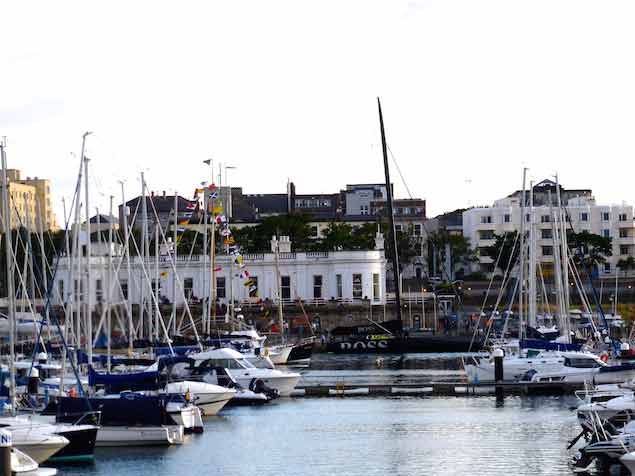 The brooding presence. The all-black IMOCA 60 Hugo Boss berthed at the Royal Irish Yacht Club. Photo: W M Nixon
The brooding presence. The all-black IMOCA 60 Hugo Boss berthed at the Royal Irish Yacht Club. Photo: W M Nixon
Yet at a different level, it is also the home port of many hobby sailors who simply see it as the conveniently-located local harbour which has ample facilities for their own sailing needs. Admittedly the affluence of the area in which it is located has meant that Dun Laoghaire has seen a significant influx of new non-woooden boats over the years, and it has lost some of the historic local One-Design classes which were once the bedrock of its highly-developed sailing scene. But even here, once it became clear that an important heritage was under threat, there has been a growing movement to preserve and expand the most historic class of all.
That has succeeded with the current great good health of the Dublin Bay Water Wag, the world’s first One-Design class, which started life as a simple double-ended little slip of a lug-rigged 13ft sailing dinghy in 1887, but by 1900 was in process of changing itself into a heftier transom-sterned gunter-sloop-rigged clinker-built boat 14ft 3ins long and 5ft 3 ins beam, with a heavy centreplate.
The new design commission was entrusted to boatbuilder J. E. Doyle in what was then Kingstown, but it’s generally reckoned the real designer was his daughter Maimie Doyle, whose talent lay in putting manners on her father’s extremely rough and often nonexistent sketches.
Whatever the design origins, the new boats were soon popular. But with other larger One-Designs available locally, each with its own adherents, it was thought good going if the racing turnout for the new Water Wags climbed above the fifteen mark before the Great War of 1914-1918.
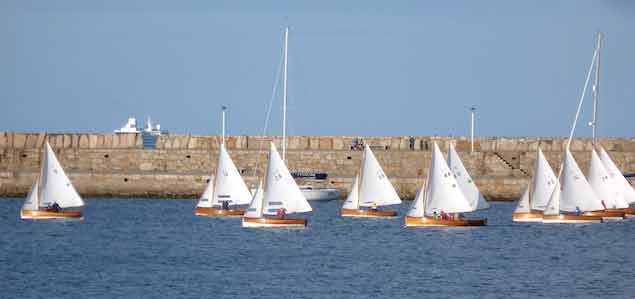 Race on! The Water Wags and Dun Laoghaire Harbour seem made for each other. Photo: W M Nixon
Race on! The Water Wags and Dun Laoghaire Harbour seem made for each other. Photo: W M Nixon
Dublin Bay proved to be ideal for the encouragement of several One-Design classes, but over the years the classic larger wooden boats left the stage to be replaced by more modern plastic boats, with the Dublin Bay 21s exiting in 1986, while in 2004 the Dublin Bay 24s sailed their last race, yet today it could be argued that they’ve been replaced by the growing Dublin Bay J/109 fleet.
A couple of post-World War II timber-built classes are still active in the Glens and the IDRA 14s, but the 17ft Dublin Bay Mermaids of 1932 provenance which originated in Dun Laoghaire are only a token presence, even if they thrive elsewhere. So now the main thrust of Dun Laoghaire enthusiasm for genuine classics sailing has devolved on the Water Wags, which today prosper as never before, and in 2017 with noted maritime historian Hal Sisk as the very active Class Captain, it was hoped they might finally achieve a racing turnout of 30 boats on the starting line.
One hundred and thirty years to become an overnight success? It could only happen in Dun Laoghaire. But as the Water Wags have been such a key part of the sailing fabric of this great harbour for so long, those in the know were well aware that the evening of Wednesday 30th August was the date set for the very special big push, the extra effort towards topping the thirty mark with the racing for the Captain’s Prize, with the fleet including helms and crews with Olympic experience.
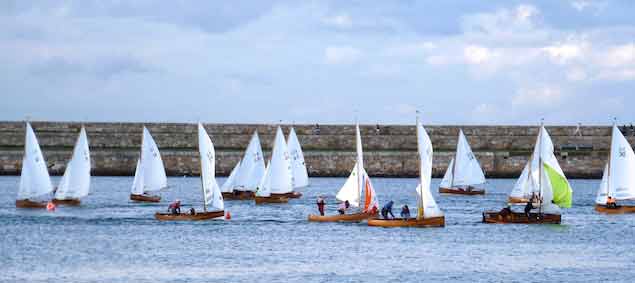 With the class rules’ insistence that spinnakers be set classical style entirely to weather, speed of setting varies enormously. Photo: W M Nixon
With the class rules’ insistence that spinnakers be set classical style entirely to weather, speed of setting varies enormously. Photo: W M Nixon
That racing in turn would be rounded out by a dinner held in the Captain’s own club to end the season’s evening racing. The Water Wags’ home bases are spread along the three older waterfront clubs, so the Captain’s Prize dinner 2017 was already scheduled for Hal’s own club, the Royal Irish, when news emerged that the mighty Hugo Boss, with the new Thomson/O’Leary combo on board, hoped to visit Dun Laoghaire for a couple of days in the last week of August, and could the RIYC accommodate their promotional needs to be seen, be accessible, and provide a base for shore entertainment?
The visit would clash either with the Water Wags special race on Wednesday, or with the regular big-turnout Dublin Bay Sailing Club keelboat racing on Thursday. It fell to the RIYC’s Rear Commodore (House) Jacqueline McStay to decide how to play it, and she played a blinder.
Where others saw a problem, she saw an opportunity. She suggested that the planned dinners for the Water Wags and those involved with Hugo Boss should be turned into one single free-form event, using the RIYC’s historic dining room and spreading into the drawing room next door. She further suggested that as the Water Wags had seniority, Hal Sisk should be the main – indeed, possibly the only - speaker at the actual dinner.
But then, with a touch of genius, she suggested that while the Water Wags were out racing, it would be ever so obliging if Alex, Nin, and their genius boffin-organiser Stewart Hosford could give a little presentation to an audience of members and friends, in the club’s extensive basement room, about themselves, their own plans, and the boat’s movements in the weeks, months and maybe years ahead.
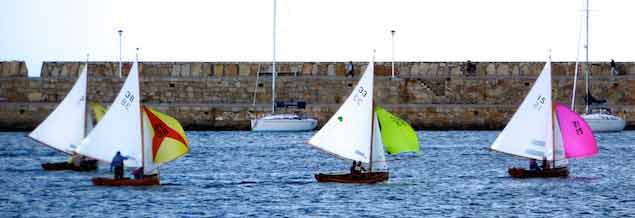 The leaders begin to emerge from the pack, with eventual winner Moosmie leading from Eva (33, Katie Tingle & Dermot O’Flynn), Swift (38, Guy Kilroy, sailed by David Somerville) and Pansy (3, Vincent Delany) Photo: W M Nixon
The leaders begin to emerge from the pack, with eventual winner Moosmie leading from Eva (33, Katie Tingle & Dermot O’Flynn), Swift (38, Guy Kilroy, sailed by David Somerville) and Pansy (3, Vincent Delany) Photo: W M Nixon
It was a masterplan for non-stop nautical entertainment for about six hours, beginning with the sniff around the Hugo Boss (“mighty machine” is an inadequate phrase here) followed by seeing the early stages of the Water Wags’ historic race, then breaking away to take in the presentation by the Talented Three in the basement, followed by the dinner when history and modernity got together, with the enjoyment of this providing a relaxed atmosphere for the exchange of information.
Pessimists would reckon this complex programme for one night in one club had endless opportunities for the wheels to come off, but it went so well you’d swear they did this sort of thing at least five nights a week. As with all Irish events of an outdoor/indoor nature, the Great Imponderable was the weather, and the forecast 24 hours earlier wasn’t at all cheerful. Yet despite that they managed to rouse out a world record of 31 “new” Water Wags, and the photos say everything about perfect conditions for the last evening race of the summer.
 A shared harbour. Trainee crew out for the evening with St Michael’s Rowing Club.Photo: W M Nixon
A shared harbour. Trainee crew out for the evening with St Michael’s Rowing Club.Photo: W M Nixon
It also provided ideal circumstances for a consideration of the current condition of Dun Laoghaire. The place isn’t helped by being in a state of limbo. I’d optimistically hoped that I could get a good shoreside overview of the race by somehow getting myself to the end of St Michael’s Pier at mid-harbour, but it’s still all blocked off as they battle back and forth about the provision or otherwise of a liner berth.
In other words, the shoreside of the harbour is basically inaccessible to the public except down the marina breakwater, but even that limited viewpoint showed that this was a race in a million. And the quality of construction of the main harbour is such that it’s a joy to behold on such an evening, while within it the Water Wags shared the space with skiffs of St Michael’s Rowing Club and boats out from the Irish National Sailing School. Conditions improved as the race went along, with a freshening breeze sharpened up by a long black cloud which moved slowly over towards Howth, leaving crisp evening sunshine behind it, and a markedly veering breeze for the final beat of a four leg windward-leeward course.
 Moosmie (15) seems to have it nicely under control going over to the tricky west side of the harbour…….Photo: W M Nixon
Moosmie (15) seems to have it nicely under control going over to the tricky west side of the harbour…….Photo: W M Nixon
 ……but finds herself at the weather mark temporarily behind Swift (38, Guy Kilroy sailed by David Somerville) and Pansy (3, Vincent Delany) Photo: W M Nixon
……but finds herself at the weather mark temporarily behind Swift (38, Guy Kilroy sailed by David Somerville) and Pansy (3, Vincent Delany) Photo: W M Nixon
 Moosmie clear ahead again. Photo: W M Nixon
Moosmie clear ahead again. Photo: W M Nixon
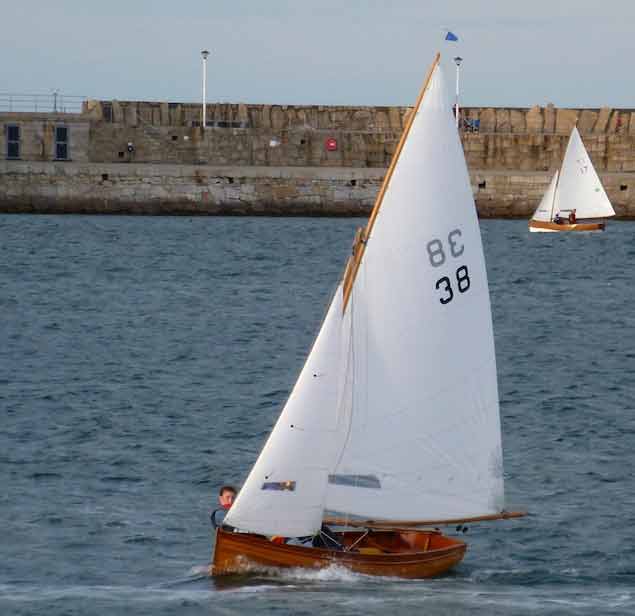 Modern sail-making materials have greatly improved the appearance of the Water Wags. With cotton sails, they often had a starved look, but today’s sailplan looks well fed. This is Guy Kilroy’s 2001-built Swift raced on Wednesday to fifth place by David Somerville. Photo: W M Nixon
Modern sail-making materials have greatly improved the appearance of the Water Wags. With cotton sails, they often had a starved look, but today’s sailplan looks well fed. This is Guy Kilroy’s 2001-built Swift raced on Wednesday to fifth place by David Somerville. Photo: W M Nixon
Thus although David and Sally MacFarlane in the 107-year-old Moosmie (no 15) had overcome a setback or two to retain the lead and sometimes show well clear ahead, the finish came with a bit of a rush of boats in from the right hand side of the beat. While Cathy MacAleavey and Con Murphy were second across in her new Mariposa, finish signal came there none - they’d been OCS. But it was the night of nights for the class’s only Howth owners, Ian & Judith Malcolm with the 102-year-old Barbara. They’d been 21st round the leeward mark, but went onto port and headed straight at that black cloud sitting plumb over their house on the southwestern flanks of the Hill of Howth.
They got themselves a mighty freeing for the tack to starboard, and came roaring in toward the finish picking off places by the handful, and finding that the leaders for much of the race were in a bit of a tangle towards the line. So they weathered the lot of them and swept in to take a neat second, making it non-Dun Laoghaire sailors in two of the top places for this Race of Races, as Katie Tingle of Cork was third and winner of IB with Eva, crewed by Dermot O’Flynn.
 Back to base. Hugo Boss waiting to welcome William Prentice & Moiselle Hogan’s Tortoise (42, built 2006, placed 4th) and winner Mousmie (built 1910) as they return to the Royal Irish YC. Photo: W M Nixon
Back to base. Hugo Boss waiting to welcome William Prentice & Moiselle Hogan’s Tortoise (42, built 2006, placed 4th) and winner Mousmie (built 1910) as they return to the Royal Irish YC. Photo: W M Nixon
 Help is always welcome when hauling a Water Wag on the slip, even at high water. Photo: W M Nixon
Help is always welcome when hauling a Water Wag on the slip, even at high water. Photo: W M Nixon
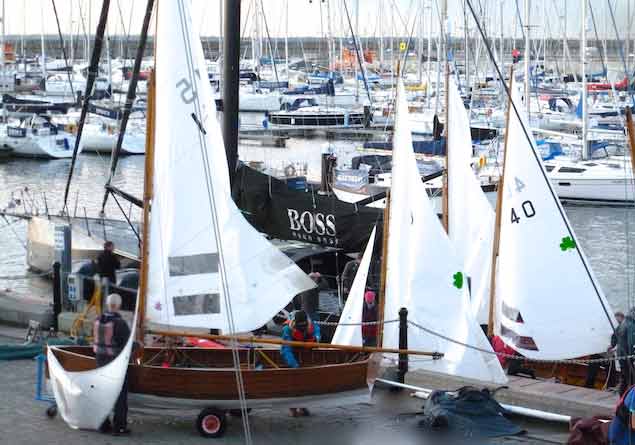 The perfect evening. The winner Moosmie (foreground) is un-rigged after being the first to win from 30 other boats, and Hugo Boss is there to see it all happen. Photo: W M Nixon
The perfect evening. The winner Moosmie (foreground) is un-rigged after being the first to win from 30 other boats, and Hugo Boss is there to see it all happen. Photo: W M Nixon
It’s a good idea to do well in the racing, as it lessens your queuing time to get up the club slips. The atmosphere around the Water Wags is so basically light-hearted – even when they’re hauling these quite heavy little boats back up the slip – that it took a while to adjust to the next mood-stage of the evening, the underlying utter seriousness involved in racing an IMOCA 60 like Hugo Boss, and particularly in such totally extreme sport as the Vendee Globe Race. Alex Thomson does a wonderful line in light-hearted patter, but what he does is mind-blowingly all-involving, and as he talked us through the financial, physical and most importantly psychological requirements for anyone even beginning to contemplate such a thing, you were left in bewilderment in grasping the scale of it all.
As to the matter of how and why he moves about the boat without being apparently concerned about being directly attached to her, he created a certain silence by saying that as you’re often sailing at 25 knots, going overboard on the end of a wire or something similar would bring the certainty of getting dragged to a particularly nasty drowning death.
Only a hundred or so people have managed to sail round the world non-stop, so there’s a real sense of community among those who have done it, and they in turn respect those who have made a whole-hearted attempt to do the same. A real high-point came when Enda O Coineen burst out of the audience and went forward to present his old mate Alex Thomson with a replacement cap for one which had been exchanged a long time ago.
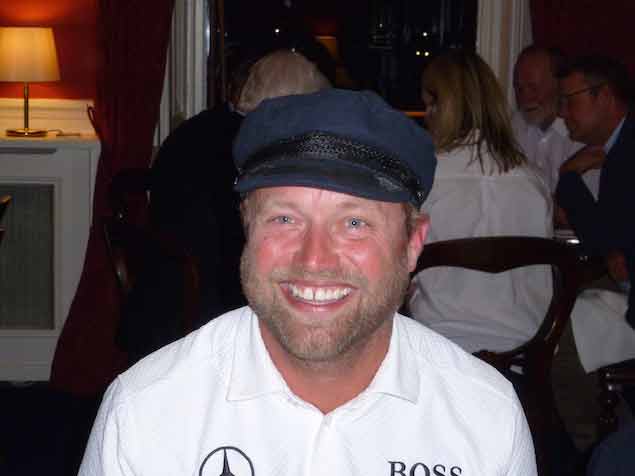 Alex Thomson with his new cap from Enda O Coineen. Photo: W M Nixon
Alex Thomson with his new cap from Enda O Coineen. Photo: W M Nixon
Stewart Hosford didn’t quite bewilder us with science, but he has such mental energy that there are times you think he’s operating on a different planet, while as for Nin O’Leary, he talked of their hopes and how he is finding it all coming together - or not. He faces a monumental challenge.
Certainly fund-raising is something that all these sailing superstars seem to gravitate towards pretty quickly, and it was in the Water Wags/Hugo Boss dinner afterwards that we could ask real questions, for the gathering in the basement room had been a pubic presentation and emphatically not a press conference. Come to that, nor was the dinner either, but things gets said across a table, and an early revelation from a notable Man Who Knows in the RIYC was that the next America’s Cup will be in skinny 73ft monohulls with enormous canting keels, which would seem to indicate that the Alinghi man who was the real backer of Team NZ is carrying the day.
Then, in his Water Wag Class Captain’s speech, Hal Sisk was in fine form, handing out the prizes with style, and taking the opportunity to present Alex Thompson with his fascinating book which convincingly argues that Dublin Bay was the cradle of modern yacht racing. Knowing that Baghdad was the cradle of civilisation, I’m not too sure that being the cradle of anything is necessarily a good thing for future prospects, but doubtless the book will have a special place in Hugo Boss’s on-board library.
As a very pleasant evening wore on, the talk became more relaxed, and in chatting about the lack of Fastnet Race success, Nin O’Leary confirmed that the construction of Hugo Boss is so specialised that any modification to fit ordinary dagger boards instead of foils would be prohibitively expense, and of limited use in hitting the overall target of a boat designed specifically for Vendee conditions, which are 90% offwind.
Thus in that frustrating upwind slog from Land’s End to the Fastnet, when holding on port tack was soon the only choice because of the huge Traffic Separation Zone, they were making ten degrees of leeway. And once they finally got to the Fastnet, there just weren’t enough miles left in getting to Plymouth to take more than one place in the IMOCA 60 class.
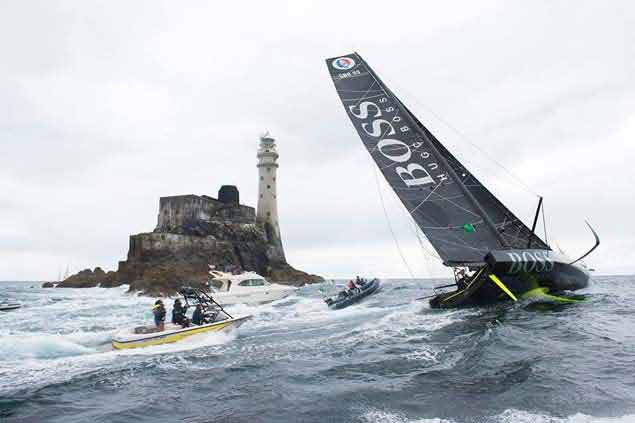 Hugo Boss with the fan club as she arrives at the Fastnet. The extreme offwind foil configuration means she makes about ten degrees of leeway when hard on the wind
Hugo Boss with the fan club as she arrives at the Fastnet. The extreme offwind foil configuration means she makes about ten degrees of leeway when hard on the wind
The problem is that with such a purpose-designed boat, the number of useful events is limited. In the interim, between races which suit, they have to make do with what’s available, so their next outing will be the Middle Sea Race on 28th October. The winds in that are notoriously all over the place, but who knows, they might get lucky, and it’s all experience even though they’re allowed to carry extra hands. But it won’t be more than three at most, as more bodies just get in the way in a cockpit optimised for one.
For Alex Thomson, the Hugo Boss sponsorship, with major support from Mercedes, is in place for 2020, but his team are willing to take in any extra interest, as the boat we were being amazed by at the Royal Irish cost a basic of €5 million, and a new one won’t be any cheaper. As for Nin O’Leary, he seems to be aiming for a boat he can initially secure for €3.6 million, but will need continuing investment thereafter.
 Stewart Hosford and Nin O’Leary
Stewart Hosford and Nin O’Leary
You cannot but be intrigued by the Hugo Boss setup. The boat looks and is the quintessential expression of modern German industry and commerce. Yet she’s sailed by a jolly Englishman whose main performance theatre is provided by France. And the technical management behind it all is provided by a peripatetic Corkman.
Into this whirling maelstrom of possbilities and challenges has stepped a 31-year-old Irish sailing star who is learning just as fast as he can by sailing as co-skipper on Hugo Boss, yet the logic is that he in time will have to think of his own boat. In fact, everybody is taking a very mature approach to this. The only relative certainty is that they’ll be doing the Middle Sea Race together in eight weeks time. Beyond that, the ideal might be the two-handed Barcelona World Race in May 2018, but if Nin O’Leary has his own boat by that time, then he’ll be going with that, and Alex Thomson will have to find another co-sailor.
It’s a world of long-term goals in which you have to be prepared for changing situations from minute to minute, or even second to second. We’re astonished by the sheer challenge of the big events, without thinking of the shoreside work. The bigger the sponsorship, the more demanding the sponsor will expect to be of the star’s time.
Set against the innocent amateur sport of Water Wag racing, the contrast was total. You really couldn’t have asked for a better way of grasping the enormity of what these guys take on.
Nin O'Leary Sails into the Royal Irish Yacht Club For Dublin Launch of Irish Vendee Globe Campaign
The nation’s first offshore racing entity, 'Ireland Ocean Racing', made its Dublin landfall last night at the Royal Irish Yacht Club in Dun Laoghaire to announce its 2020 Vendée Globe campaign to an RIYC gathering.
Only 100 people have sailed single handed non-stop around the world and no Irish sailors have yet completed the Vendée Globe event but if Royal Cork's Nicholas O'Leary has his way, he'll be the first, the sailing crowd at the RIYC heard last night.
The club was buzzing with sailors as a world record turnout of Water Wags was achieved during the Captain's Prize race staged at the RIYC.
As Afloat.ie has previously reported, leading Irish sailor 'Nin' O’Leary will skipper the Irish entry and he aims to be the first Irish sailor to complete this exciting and incredibly arduous sporting challenge.
His boat for the campaign, Hugo Boss sped across Dublin Bay yesterday afternoon with both Alex Thomson and O'Leary onboard. More Dublin Bay sails are planned to day and tomorrow.
Having shown Cork what the IMOCA 60 Hugo Boss can do, and even scored a photo op with the Durcan brothers, Nin O’Leary sailed into Dun Laoghaire yesterday morning on a mission that could define his Vendée Globe campaign. Speaking to Tom MacSweeney, he tells of his dream to race a “Formula 1” yacht in 2020, adding “I’m a very competitive guy”. But can he win his first battle to sup from the small sponsorship pot? That, admits team manager Stewart Hosford, is the €3million question. Listen to the full interview here.
Nin has competed across a range of sailing and racing events from an early age and has raced with his father, Anthony O’Leary, and brothers, Olympic sailor Peter O’Leary and Irish Champion sailor Robert O’Leary, to many victories. His achievements include winning the prestigious All Ireland ‘Champion of Champions’ an unprecedented three times, as well as being part of the Yes! Racing team.
Nin added his thoughts on his recent announcements:
“This is an important day for Irish offshore sailing and for me personally to lead the first Ireland Ocean Racing project . The campaign over the next 4 years building up to the Vendée Globe offers sponsors and investors a perfect partnership platform including branding, hospitality and dramatic content. I have just completed the Fastnet race with co-skipper Alex Thomson and now the real work starts in order to achieve the biggest challenge of all – the 2020 Vendée Globe.




























